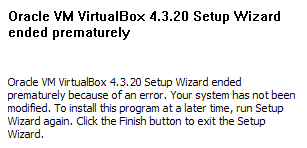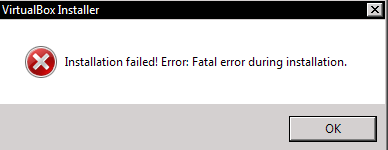I was preparing for an Oracle online workshop on Database 12c multi-tenancy, and as part of the prep, you get to download a VM image with the lab environment. Of course, being Oracle, it is a Virtual Box vm.
Now, I like Virtual Box. It works great on my Mac at home, but for some reason I’ve had problems installing 4.x on my work laptop (Lenovo W520, getting on a bit now but still recommended).
The problem is Virtual Box almost completely installs – until it gets a certain point, then the progress bar runs backwards and it says “rolling back install”, followed by:

“Oracle VM VirtualBox 4.3.20 Setup Wizard ended prematurely” because of “an error”. This is followed up by “Installation failed! Fatal error during installation.”.

No other information provided. Running as Adminstrator after a cold reboot didn’t help.
Well… I really wanted to have the Workshop lab environment available, so despite the fact that last time I encountered this problem I didn’t find any useful help on the web, I tried again… and this time, I found something on the forums, a post by user Tronmech:
https://forums.virtualbox.org/viewtopic.php?f=6&t=61785
I’ll repeat the instructions here in case for some reason that post vanishes:
- Go into the registry at: HKEY_LOCAL_MACHINE\SYSTEM\ControlSet001\Control\Network
- Change “MaxNumFilters” from 8 to 20 (decimal)
- Reboot
- Install 4.3.x (run installer as administrator, just in case)
This time, the install was successful. Thanks, Tronmech!
After some more research, it seems that Windows 7 has a maximum hard-coded limit of 14 network filter drivers… and for some reason, this setting in the registry reduces it further to 8, by default.
So setting the MaxNumFilters key to 20 probably only lifts the artificial limit and allows 14 possible filters. Applications such as Virtual Machine managers and VPN clients need to add filters to the network stack, and increasing this limit in the registry seems to be the recommended fix.
In one KB article, I read that a Windows Service Pack could not be installed until some filters were removed!
To view currently deployed Network Filter Drivers, right-click on your connection widget in the Network Connections control panel applet, and view properties:
I believe that each of those checkboxed items is a “Network Filter Driver”. I have 9 of them, and I assume that the “VirtualBox Bridged Networking” driver was the 9th one added after I lifted the limit of 8.
Recent Comments